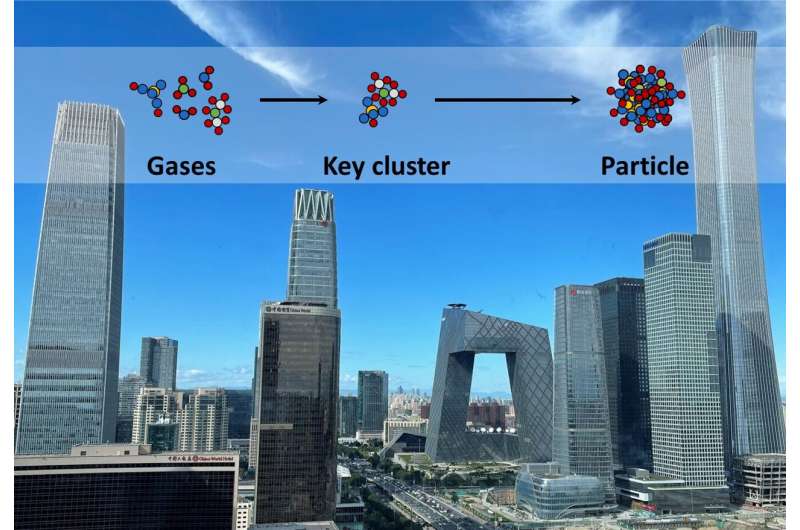Hidden acid-base clusters drive rapid formation of atmospheric ultrafine particles

A joint research team led by Dr. Jingkun Jiang from Tsinghua University and Dr. Markku Kulmala from the University of Helsinki has reported an efficient mechanism for gaseous sulfuric acid and bases to form atmospheric ultrafine particles. The findings explain the rapid formation of secondary ultrafine particles, which could further influence air quality and the climate.
The team found that acid-base reactions are the major driving forces for gaseous precursors to overcome surface tension and form ultrafine particles, and the key mechanism is the formation of hidden acid-base heterodimers. This hidden mechanism explains the high particle formation rate in Chinese megacities.
Their findings were published in National Science Review.
“There are hundreds of thousands of ultrafine particles in per cubic centimeter air in Chinese megacities, and a new particle formation event on a sunny noon can readily elevate their concentration by one order of magnitude within several hours,” Jiang says.
To explain how new particles can be so efficiently converted from gaseous precursors, Jiang and Kulmala, together with Dr. Runlong Cai, are determined to seek the key mechanism for rapid new particle formation. They have known that sulfuric acid is a primary precursor, whereas the challenge is to find the key bases among many candidates. “Urban air is a complex cocktail of chemicals with poorly understood interactions and feedbacks,” Kulmala commented.
The researchers observed highly abundant molecular clusters containing sulfuric acid during new particle formation in Beijing and Shanghai. Some of the measured clusters contain sulfuric acid and amine molecules. These provide strong evidence for amine participation in the formation of stable sulfuric acid clusters, which increases the conversion rate from gaseous sulfuric acid to new particles.
“It is intriguing that we measured fewer bases than acids in a cluster. There must be some key information hidden behind the measured signals,” Cai says. It was previously proposed that the clustering between a base molecule and a sulfuric acid homodimer is the key mechanism for new particle formation, as there were no base molecules in the measured clusters containing one sulfuric acid molecule. The research team, however, found that this was a measurement artifact.
Combining long-term measurements and theory based on quantum chemistry and cluster kinetics, they found that the formation of hidden acid-base heterodimers is the key mechanism. This mechanism is far more efficient than the previously proposed mechanism with acid-acid homodimers, ensuring the rapid formation of sulfuric acid clusters and new particles.
The hidden heterodimers solve the puzzle of why new particles could be frequently formed against a high background particle loading in megacities. The hidden acid-base heterodimers with a considerable fraction in the measured sulfuric acid signals can effectively cluster with each other. This ensures a high particle formation rate approaching the theoretical maximum even at a low ambient amine concentration. The hidden heterodimers also explain the temperature dependency of new particle formation in Beijing and Shanghai. “Atmospheric measurements are often perturbed by many factors. I did not expect such an amazing consistency between the measurements and the new theory,” Cai says.
The team also sought the hidden base molecules using thermodynamic and kinetic analyses. Among the measured gaseous molecules, strong amines such as dimethylamine serve as the key bases in acid-base heterodimers, whereas the highly abundant ammonia and other weak bases are more likely to be involved in the subsequent cluster growth process.
Scientists observe slow photoelectron spectrum of sulfuric acid in high resolution
Runlong Cai et al, The missing base molecules in atmospheric acid-base nucleation, National Science Review (2022). DOI: 10.1093/nsr/nwac137
Citation:
Hidden acid-base clusters drive rapid formation of atmospheric ultrafine particles (2022, September 2)
retrieved 2 September 2022
from https://phys.org/news/2022-09-hidden-acid-base-clusters-rapid-formation.html
This document is subject to copyright. Apart from any fair dealing for the purpose of private study or research, no
part may be reproduced without the written permission. The content is provided for information purposes only.
For all the latest Science News Click Here
For the latest news and updates, follow us on Google News.

